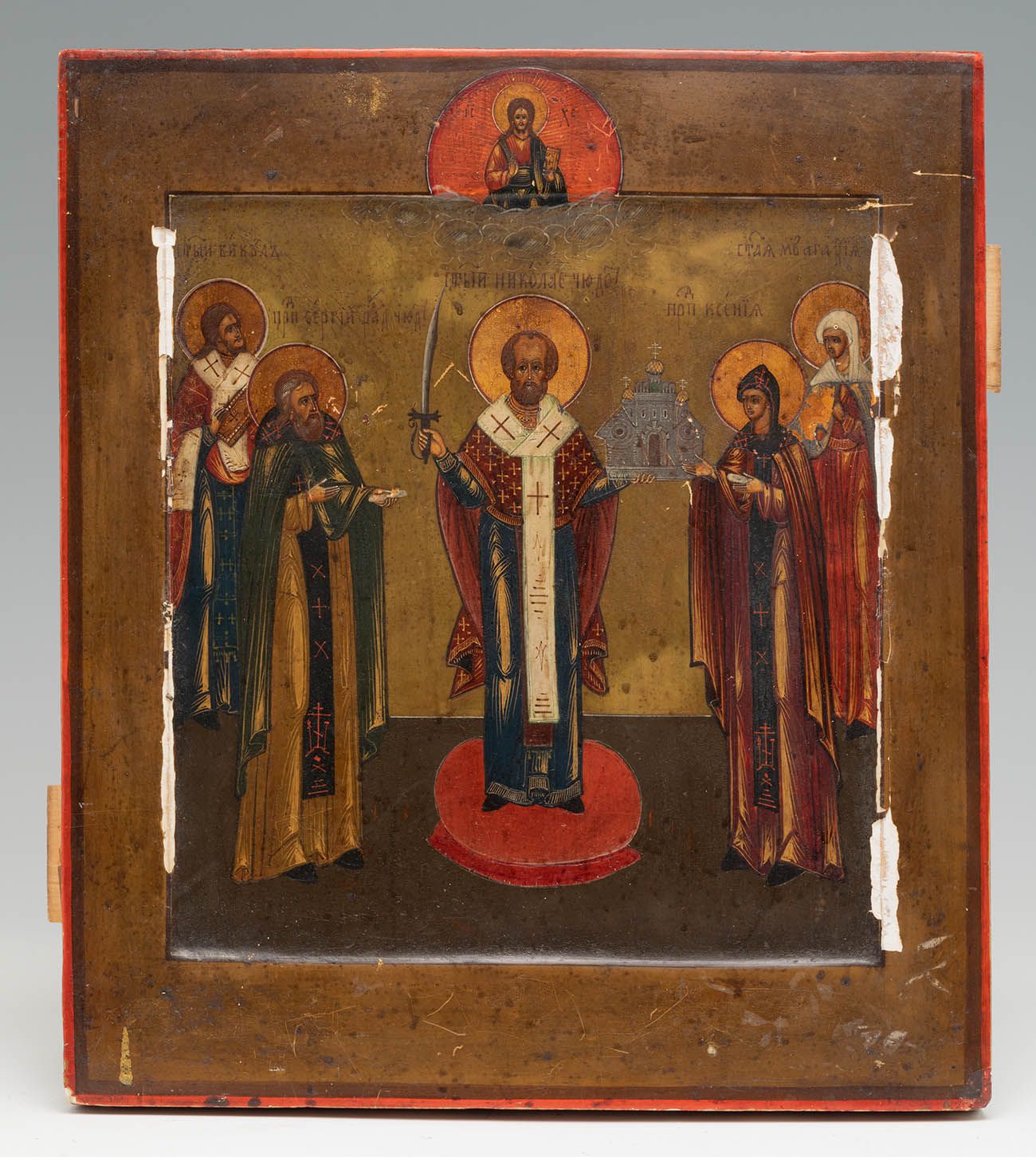Description
Russian School of Moscow, 17th-18th century. "Saint Nicholas of Mozhaisk with Sergiy Radonezhskiy and Saint Xenia". Tempera on panel. Measurements: 35 x 31 cm. The icon of interest represents an unusual composition of St. Nicholas the Miracle-Maker, therefore very valuable when appreciating the cult of the saint. It is a reference to the apparition of St. Nicholas the Wonderworker in Mozhaisk. There are several versions of hagiographies of the saint, describing his miracles during his lifetime and after his death. In 1087, the relics of the saint were transferred from Myra (Lycia) to the Italian city of Bari. After this event, the veneration of the saint developed in Russia. In honour of the transfer of the relics to the Russian Orthodox Church, a special feast was instituted, which did not exist in Byzantium. The saint was worshipped as a great bishop of Christ, equal to the rank of an apostle. In turn, the auctioned icon recounts an unusual passage from the postmortem life of the saint, which was properly developed in Russia. It is linked to the legend of the miraculous rescue of the town Mozhaisk, located between Moscow and Smolensk, from a sudden enemy attack. The inhabitants of Mozhaisk, whose town was an important defensive fortress on Russia's western borders, were accustomed to expect the threat of the Lithuanians and Poles. However, at the beginning of the 15th century, the inhabitants of the city faced a new one, the Tatar khan Yedigei. The Tatar nomads managed to burn down a large part of the town, including the church. After what happened, St. Nicholas appeared holding a sword in one hand and the fortress and the church in the other. In gratitude for the saint's miraculous help, the citizens of Mozhaisk carved a wooden icon, on which they depicted Miraculous Nicholas in the form they remembered him in the vision. One of the oldest versions of the icon, which is considered to be the first sculpture of St. Nicholas of Mozhaisk, was carved from oak in the 15th century. Since then, Miraculous Nicholas came to be perceived not only as the patron saint of Mozhaisk, but also as the defender of all the cities of the Russian land. For example, a stone church of St. Nicholas of Mozhaisk was built in Murom with the money of Ivan the Terrible after a successful campaign in Kazan. The sword of St. Nicholas is a reminder of the spiritual sword, which, according to St. Paul, "is the Word of God". In the case of this icon, the church is depicted without the walled building of the Mozhaisk Kremlin.
58
Russian School of Moscow, 17th-18th century. "Saint Nicholas of Mozhaisk with Sergiy Radonezhskiy and Saint Xenia". Tempera on panel. Measurements: 35 x 31 cm. The icon of interest represents an unusual composition of St. Nicholas the Miracle-Maker, therefore very valuable when appreciating the cult of the saint. It is a reference to the apparition of St. Nicholas the Wonderworker in Mozhaisk. There are several versions of hagiographies of the saint, describing his miracles during his lifetime and after his death. In 1087, the relics of the saint were transferred from Myra (Lycia) to the Italian city of Bari. After this event, the veneration of the saint developed in Russia. In honour of the transfer of the relics to the Russian Orthodox Church, a special feast was instituted, which did not exist in Byzantium. The saint was worshipped as a great bishop of Christ, equal to the rank of an apostle. In turn, the auctioned icon recounts an unusual passage from the postmortem life of the saint, which was properly developed in Russia. It is linked to the legend of the miraculous rescue of the town Mozhaisk, located between Moscow and Smolensk, from a sudden enemy attack. The inhabitants of Mozhaisk, whose town was an important defensive fortress on Russia's western borders, were accustomed to expect the threat of the Lithuanians and Poles. However, at the beginning of the 15th century, the inhabitants of the city faced a new one, the Tatar khan Yedigei. The Tatar nomads managed to burn down a large part of the town, including the church. After what happened, St. Nicholas appeared holding a sword in one hand and the fortress and the church in the other. In gratitude for the saint's miraculous help, the citizens of Mozhaisk carved a wooden icon, on which they depicted Miraculous Nicholas in the form they remembered him in the vision. One of the oldest versions of the icon, which is considered to be the first sculpture of St. Nicholas of Mozhaisk, was carved from oak in the 15th century. Since then, Miraculous Nicholas came to be perceived not only as the patron saint of Mozhaisk, but also as the defender of all the cities of the Russian land. For example, a stone church of St. Nicholas of Mozhaisk was built in Murom with the money of Ivan the Terrible after a successful campaign in Kazan. The sword of St. Nicholas is a reminder of the spiritual sword, which, according to St. Paul, "is the Word of God". In the case of this icon, the church is depicted without the walled building of the Mozhaisk Kremlin.
